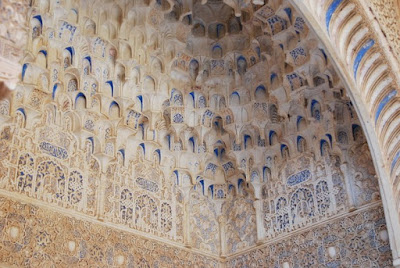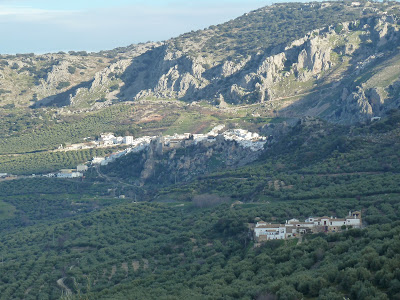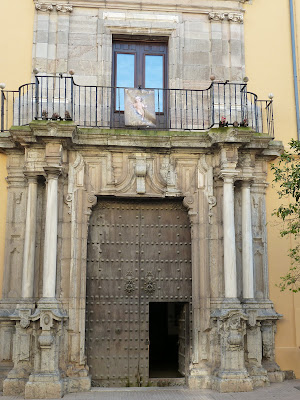The beauty of the Alhambra comes from several sources. First, the Moorish architecture with hundreds of columns and arches, intricate carved ceilings and walls and courtyards with reflecting pools. While we had seen all of these things in Sevilla, the Alhambra was of a higher quality and a much grander scale. Second, the location provides a commanding view of the valley and of the mountains in the background. Much of the Alhambra was built in the 14th century -- it must have been very imposing for visitors approaching Granada to see this huge fortress on top of a hill. Finally, the gardens softened the effect of all that stone to provide a quiet place to walk.
 |
| Our hotel in Granada was a restored 15th century building |
 |
| The snow capped Sierra Nevada's |
 |
| View of the city from the Alhambra |
 |
| Some of the wall carvings at the Alhambra. Note the Arabic poetry near the bottom. |
 |
| Intricate ceiling at the Alhambra |
 |
| More Alhambra detail |
 |
| More Alhambra detail |
 |
| In the gardens of the Alhambra |
 |
| Some of the Alhambra fortress walls |
 |
| Alhambra reflecting pool |
 |
| The Alhambra at night as viewed from the city. |
 |
| Alhambra Gardens |
Granada is also where Queen Isabella and King Ferdinand are buried. The "Catholic Monarchs" led the recapture of Granada from the Moor's in 1492, creating a unified Spain. Unfortunately, it also created an environment where Muslims and Jews were expelled to provide religous harmony. Among other notable (and more positive) accomplisments, Isabella and Ferdinand commissioned Christopher Columbus' voyage to the New World. The two monarchs are buried in the Royal Chapel along with their daughter, Juana la Loca (Joanna the Mad) and her husband, Felipe el Hermoso (Philip the Handsome). Philip must have been quite handsome. He died young and his wife, Juana, had his lead casket carried with her so that she could lift the lid and kiss him each night. Her name appears to suit her well.
 |
| The Cathedral as viewed from Alhambra |
 |
| Stained glass in the Cathedral |
 |
| Inside the Cathedral |
 |
| Columbus requesting support from Queen Isabella |
 |
| Many of the balconies in Spain had Santa's climbing up the railing. This is the only balcony I saw that had the three Wise Men making their delivery. |
The drive from Granda to Cordoba went through a beautiful range of small mountains whose slopes were covered with olive trees. In some places it seemed like there were olive trees as far as you could see, and we could see pretty far. I had planned to write all about olive ranching, but fate intervened. We stopped in the small town of Baena intending to visit the Museo del Olivar y el Aceite (Olive Oil Museum). Recognizing that they would close for siesta from 2 - 4:00, we timed our visit to arrive precisely at 4:00. Unfortunately, during the hoilday week they adjusted their hours to only be OPEN from 2 - 4:00 each day. So your lesson on olives will have to wait until we visit Italy.
 |
| Note the olive groves in the background. We saw groves like this for two hours of our drive. |
 |
| The town of Zuheros built into the side of the mountain. We ate lunch at a the set of white buildings in the foreground. |
 |
| An abandoned fortress/cathedral that we saw on the drive to Cordoba |
 |
| Cats are the same around the world...they can't resist a warm car hood in the sun. |
 |
| Kate and Grant in front of an olive tree. Lori picked one to eat, but it was super sour. |
Our last stop on the trip was Cordoba. No we didn't see Ricardo Montalban advertising Chrysler cars. But we did see the Mezquita, or Mosque. Built between the 8th and 10th centuries, it's one of the earliest examples of Spanish Muslim architecture. After the reconquest in the 1200's, it served as a Cathedral so as you tour it today you see a building with a blend of Muslim and Catholic religions. You will note in the photo's that by this point in the trip, some members of our group had contracted a severe case of "audio-guide-itis". Their brains were simply unable to absorb any more historical facts or listen to readings of one-thousand year-old Arabic poetry. So they just walked around the Mesquita and enjoyed its beauty; something that was quite an easy thing to do.
In the category of learning more about the Spanish culture, we noticed that on the evening of January 5th, there were many elaborate parades in Cordoba and the surrounding towns. When we asked about their purpose, we learned that the Spanish large holiday celebration occurs on Epiphany, or January 6th. The parades were for the Wise Men coming and giving gifts (actually they were throwing out candy). The bakeries were selling King Cakes, which were circular similar in shape to a New Orleans King Cake, but they had some type of whipped cream filling. Supposedly, there were also a few presents in the cake. The next day, the town was empty as families stayed home and opened their presents.
 |
| The Cathedral Choir within the Mesquita. |
 |
| The Mesquita includes over 850 columns topped by ornate capitals and arches. |
 |
| The ceiling in one section of the Mesquita |
 |
| Another section of ceiling. |
 |
| An example of the detail within the Mesquita. |
 |
| I'm sure that he was a famous Cardinal in Cordoba, but he looks rather like Yoda. |
 |
| The outside of the Mesquita (on the right). |
 |
| I love the practicality of this. Install huge doors because they look nice, but cut a small door within the larger one for everyday use. |
 |
| In the Alcazar, Mosaics from the 2nd or 3rd century when the Romans ruled the Cordoba. |
 |
| A single tree that grows both oranges and lemons. |
 |
| A frequent site on the trip. We'd get lost and Lori would whip out the guidebook and save us. |
 |
| The only Jewish Synagogue in Andalusia to survive the inquisition in 1492 and one of only 3 in all of Spain. |
 |
| Carol enjoyed the local cuisine....oxtail stew. |
No comments:
Post a Comment